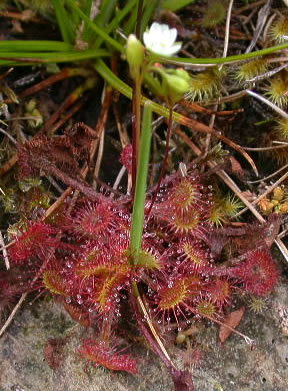|
English
name:
rondleaf
sundew
|
|
|
Own
language name: rossolis
|
|
Description:
Carnivorous
plant, vivace,
The narrow, hairy 1.3-5 centimetre long petioles support 4-10
millimetres long lamina. The upper surface of the laminais densely
covered with red glandular hairs that secrete a sticky mucillage.
A typical plant has a diameter of around 3-5 centimetres, with a 5-25
centimetre tall inflorescence. The flower grow on one side of a
single slender, hairless stalk that emanates from the centre of the leaf
rosette. White colour, the five-petalled flowers produce 1-1.5 mm light
brown seeds. In the winter, D. rotundifolia produces a
hibernaculum in order to survive the cold conditions. This consists of a
bud of tightly curled leaves at ground level.
|
|
|
Habitat:
Peaty
soils,
damp heathland, more often among the sphaignes.
|
|
|
Report about the reasons of the risk: |
|
|
Categoria IUCN: 2, CR, critically endangered
|
|
|
Possible solutions: preservation
and control of the typical biotope.
|
|
|
Culinary, medicinal and/or medicinal properties:
médicinal
plant :fresh leaves have anti-cough properties. They are used in
homeopathie against the whooping cough and asthma. In
high dose, they are irritating.
|
|
|
|

|
|
|
![]()